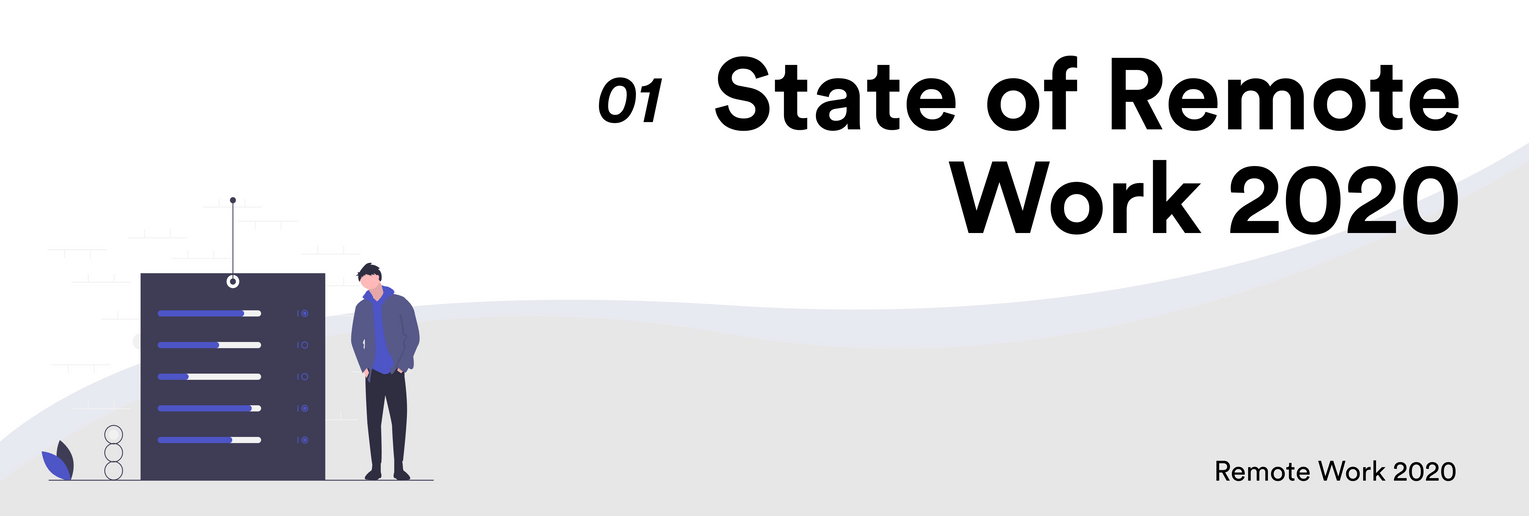
# State of Remote Work in 2020
While in the following sections, we try to propose some solutions to the various challenges of working remotely, a good place to start is to listen to the voices of the many remote workers who are already living the remote work lifestyle.
To this end, we reached out to 331 remote workers, who shared their thoughts around a multitude of topics, right from flexible work arrangements in a remote setting to work-life balance. This included individuals from companies such as Invision, Scrapinghub, Flexjobs, Doist and Gitlab, as well as independent professionals.
So, let's delve into what remote workers feel about the various aspects of remote working!
# Remote workers don't intend to get back to a co-located setting
One of the most promising trends for the future of remote work is the fact that 82% of all remote workers suggested that they never planned to return to an in-office co-located setting. Irrespective of the reason to explore remote working, this stat reflects the convenience it offers to individuals and how offering remote working opportunities might immediately make a company much more favourable to applicants.

Further, another data point corroborating with the positivity associated with remote work, is that all of our respondents said that they would recommend remote work to others. The important aspect though was that 35% mentioned that while they would like to recommend remote working to others, it also depended on the person they were recommending it to. This underlined the importance that remote working might not be for everyone or for every situation and office work might just be better for some.

We, in fact, added this option because Scott Hanford, Director of Customer Acquisition at Invision, suggested that we do so. In his words, "I would recommend it to some, but not others."
# Work flexibility is the biggest motivator to work remotely
There could be a variety of reasons to work remotely, however, the most stated one by some margin was the flexible work timings at 39%. This is an interesting stat for companies - offering flexible work hours might improve retention and employee happiness.
The other motivators stated included Avoiding long commutes (25%) and Time with loved ones (21%) thanks to flexible work arrangements. Quite in contrast to the popular depiction of remote working being pursued by individuals with "wanderlust", only 8% of our respondents selected the opportunity to travel the world and be a digital nomad as their motivator.

Further, when enquired if they were always positive about work, a majority of respondents (58%) confirmed that this is the only kind of work they always wanted to do. However, a sizeable chunk also said that they just happened to land a remote role (26%). This indicates that not only people interested in working remotely are finding such roles, but also that companies offering remote roles are finding individuals who didn't have remote working in mind but were just the best suited individuals for such roles offering flexible work arrangements.

Also, the work flexibility remote working offers helps people with personal constraints to still be able to build a solid career - 16% of our respondents stated personal reasons as the nudge to consider remote work.
As Candace Ramirez shared in her story (opens new window):
" I’ve just never felt comfortable in an office setting. I need to be cozy and completely at ease in order to focus on work. I’m a night owl too, so I do most of my best work at home in the evenings with my dog curled up at my feet.
And truthfully, there’s also a mental health benefit in it for me. I have PTSD, and working from home takes a lot of the stress out of my day.
# Battling Work-life balance and Loneliness remains tough
While remote working certainly offers numerous advantages and is quickly being adopted widely, remote workers are still figuring solutions to challenges peculiar to it, an improtant one being achieving work-life balance. Being unable to clearly demarcate work-time and personal-time along with fighting loneliness were two of the biggest challenges faced by remote workers at 27% each.
Another understandably important reason was managing work and communicating across timezones (17%). Infrastructure (8%), personal productivity (8%) and comprehending one's company's culture (3%) were other stated challenges faced by individuals working remotely solo or in a distributed team.

Alondo Brewington beautifully stated the challenge loneliness presents and the importance to tackle it (opens new window):
" While working remotely work has been largely positive, it can be very isolating and lonely. If you are not mindful of its effects, you can develop some bad habits that could negatively impact your well being.
Physical and mental health are incredibly important. I would encourage everyone to make time for fostering community and self-care while working remotely.
# Even with the growth in co-working spaces, remote workers choose to work from home
Working from home was the most popular choice among all remote workers at whopping 84% in totality. An important aspect to observe was that 63% who work from home mentioned that they have a dedicated home office. This is critical as it helps in a multitude of ways: improved productivity, better posture but also in establishing clear distinction between the work space and the personal space, also giving a push towards better work-life balance.

Co-working spaces were surprisingly not a very popular choice at 8%. Many remote workers we spoke to, stated positive effects of working in a co-working space including the opportunity to interact with others, which helps them address loneliness and improves productivity too. In alignment with the previous question, working while traveling the world as a digital nomad was selected by only 5% people.

Silvestar's (opens new window) home set up - to read his story, click here (opens new window)
# Remote work doesn't mean employees are not working, but probably working too much!
Our survey indicated that remote workers are probably working higher than the usual amount - a large part of our respondents (44%) indicated that they are working overtime, i.e. for greater than 40 hours a week and a comparable number (41%) said they work for 30-40 hours. 11% shared that they work 20-30 hours and 4%, less than 20 hours, showcasing the work flexibility that remote work offers. While for some it could be bliss, this shows that not everyone is getting the work-life balance that comes with remote work.

# Dedicated slack for interests has been the easiest and best method to enhance team bonding
Forming strong relationships in a remote team is a tough task given a lot of conversations revolve around the current work at hand. Therefore, one needs to be intentional in creating opportunities for such interactions and conducting team bonding activities.. Our respondents observed that dedicated slack channels for individuals to interact with one-another on mutual interests (34%) were one of the simplest and surest ways to form personal bonds and enhance overall team bonding.

Team offsites was next in the list at 25%, which Dave Nevogt, Co-founder & CEO of Hubstaff, mentioned was one of the most important elements of building relationships and has also helped them in employee retention. Other initiatives included team bonding activities such as informal catch-up or video calls (21%) and other ad hoc company initiatives such as pizza sessions or Movember, etc. (7%).
Scott Hanford, Director of Customer Acquisition at Invision, on a podcast with us shared the importance of slack channels:
"...things we have done where we find success at Invision and in my own team are: Channels in slack where people have certain interests. We have got about a few hundred at this point from cryptocurrency to NBA.....That's actually how you can really have like a socialisation of certain themes and things that you are interested in with other co-workers.
# Companies are slowly recognising that having a 100% remote team is better than partially remote teams
About 52% of our respondents worked in a fully-remote company. This could also be a bias based on the type of companies we reached out to. However, growing teams by taking the 100% distributed team approach has become more popular over the years given the ability to source the best talent for a particular role.

Companies still continue to offer remote working options selectively: 14% worked in companies where only certain teams were allowed to work remotely and another 11% where each individual could decide to work remotely or in a co-located setting in-office. Very few companies (1%) allowed just a few days of remote work each week.
Additionally, to aid remote workers in building a healthy and reliable workspace, 52% of respondents shared that their companies have begun to fund better infrastructure. This helps in better productivity for the employees too and sends the message that the company is fully invested in promoting remote work.

# Who took our remote work survey?
A total of 331 people took our survey. Below are some basic details about them:
By company size
The split across 4 categories: 0-10, 11-50, 51-200 and 500+ employees was very similar: ~24% in each of these categories. The remaining 4% lay in the 200-500 employees category.
By function
A large part of our respondents worked in the Engineering function at 30%. The split thereafter was 21% in Marketing, 17% as part of the Management of their respective companies, 15% in Product, 7% in HR, 7% in Strategy and finally, 2% in Sales.



